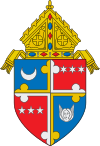
The parish of Trinity Church has three separate burial grounds associated with it in New York City. The first, Trinity Churchyard, is located in Lower Manhattan at 74 Trinity Place, near Wall Street and Broadway. Alexander Hamilton, Albert Gallatin, and Robert Fulton are buried in the downtown Trinity Churchyard.

James Hoban was an Irish-American architect, best known for designing the White House.

Mount Olivet Cemetery is an historic rural cemetery located at 1300 Bladensburg Road, NE in Washington, D.C. It is maintained by the Roman Catholic Archdiocese of Washington. The largest Catholic burial ground in the District of Columbia, it was one of the first in the city to be racially integrated.
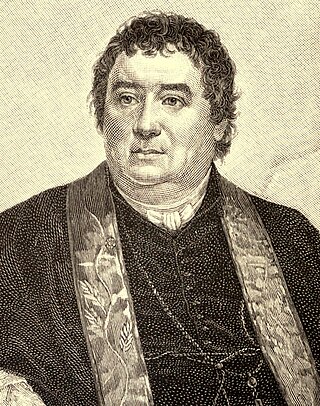
Benedict Joseph Fenwick was an American Catholic prelate, Jesuit, and educator who served as the Bishop of Boston from 1825 until his death in 1846. In 1843, he founded the College of the Holy Cross in Worcester, Massachusetts. Prior to that, he was twice the president of Georgetown College and established several educational institutions in New York City and Boston.
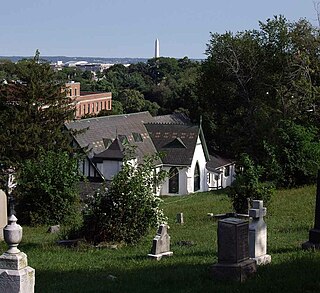
Holy Rood Cemetery is located at 2126 Wisconsin Avenue N.W. at the southern end of Glover Park, adjacent to Georgetown in Washington, D.C. It is at one of the highest elevations in the city and has memorable views. The cemetery contains approximately 7,000 burials, including as many as 1,000 free and enslaved African Americans. It may be the best-documented slave burial ground in the District of Columbia.
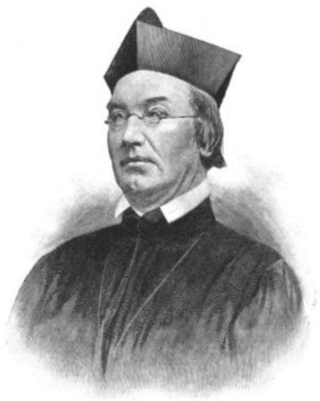
John Early was an Irish-American Catholic priest and Jesuit educator who was the president of the College of the Holy Cross and Georgetown University, as well as the founder and first president of Loyola College in Maryland. Born in Ireland, he emigrated to the United States at the age of nineteen. Upon his arrival, he enrolled at Mount St. Mary's Seminary in Maryland and entered the Society of Jesus, completing his education at Georgetown University in Washington, D.C.
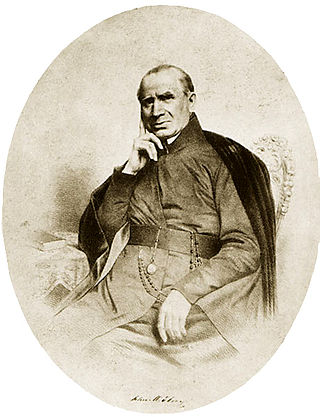
John McElroy was born in Ireland in 1782, and emigrated to the United States in 1803. McElroy enrolled in Georgetown University in 1806, the same year in which he joined the Society of Jesus as a lay brother. His brother Anthony also became a Jesuit. Fr. McElroy assumed the management of Georgetown's financial affairs. He was ordained a priest in 1817. In 1822 he was sent to Frederick, Maryland, where he was to remain for 23 years as pastor of St. John the Evangelist Catholic Church in downtown Frederick. It was in Frederick that he founded St. John's Literary Institution. During the Mexican–American War, McElroy served as an Army chaplain, and on his return from Mexico he went to Boston, where he established Boston College and Boston College High School.

St. Mary's Roman Catholic Church, also known as Old St. Mary's, is a historic church in Philadelphia, Pennsylvania. It is located in the Society Hill neighborhood at 248 S. Fourth Street, between Spruce and Walnut Streets.

Mount Zion Cemetery/Female Union Band Society Cemetery is a historic cemetery located at 27th Street NW and Mill Road NW in the Georgetown neighborhood of Washington, D.C., in the United States. The cemetery is actually two adjoining burial grounds: the Mount Zion Cemetery and Female Union Band Society Cemetery. Together these cemeteries occupy approximately three and a half acres of land. The property fronts Mill Road NW and overlooks Rock Creek Park to the rear. Mount Zion Cemetery, positioned to the East, is approximately 67,300 square feet in area; the Female Union Band Cemetery, situated to the West, contains approximately 66,500 square feet. Mount Zion Cemetery, founded in 1808 as The Old Methodist Burial Ground, was leased property later sold to Mount Zion United Methodist Church. Although the cemetery buried both White and Black persons since its inception, it served an almost exclusively African American population after 1849. In 1842, the Female Union Band Society purchased the western lot to establish a secular burying ground for African Americans. Both cemeteries were abandoned by 1950.
Adalbert Olszewski "Albert" Von Herbulis was an architect who practiced in Washington, D.C., who is best known for having designed the Cathedral of St. Helena in Helena, Montana.

The Presbyterian Burying Ground, also known as the Old Presbyterian Burying Ground, was a historic cemetery which existed between 1802 and 1909 in the Georgetown neighborhood of Washington, D.C., in the United States. It was one of the most prominent cemeteries in the city until the 1860s. Burials there tapered significantly after Oak Hill Cemetery was founded nearby in 1848. The Presbyterian Burying Ground closed to new burials in 1887, and about 500 to 700 bodies were disinterred after 1891 when an attempt was made to demolish the cemetery and use the land for housing. The remaining graves fell into extensive disrepair. After a decade of effort, the District of Columbia purchased the cemetery in 1909 and built Volta Park there, leaving nearly 2,000 bodies buried at the site. Occasional human remains and tombstones have been discovered at the park since its construction. A number of figures important in the early history of Georgetown and Washington, D.C., military figures, politicians, merchants, and others were buried at Presbyterian Burying Ground.

Thomas Corcoran Jr. was an Irish American merchant who served as mayor of the town of Georgetown, District of Columbia and 22 terms on the Georgetown Common Council. He also held several appointed positions with the state of Maryland and the District of Columbia. He was one of Georgetown's and Washington's first philanthropists, and the father of banker and philanthropist William Wilson Corcoran.
Holmead's Burying Ground, also known as Holmead's Cemetery and the Western Burial Ground, was a historic 2.94-acre (11,900 m2) cemetery located in the Dupont Circle neighborhood of Washington, D.C., in the United States. It was founded by Anthony Holmead in 1794 as a privately owned secular cemetery open to the public. The city of Washington, D.C., constructed the Western Burial Ground on the remainder of the city block in 1798, and the two burial grounds became synonymous. The city took ownership of the private Holmead cemetery in 1820. The unified cemetery went into steep decline around 1850, and it was closed on March 6, 1874. Removal of remains, most of which were reinterred at Graceland Cemetery or Rock Creek Cemetery, continued until 1885.
Francisco Xavier de la Paz Pizarro Martínez was a Mexican diplomat who served as Envoy Extraordinary and Minister Plenipotentiary of Mexico to the United States from 17 October 1837 until his death on 9 February 1840. Previously, Pizarro served as Mexican consul to New Orleans.

The Basilica of Saint Mary in the Old Town Old and Historic District, of Alexandria, Virginia, and is a minor basilica and parish church of the Roman Catholic Diocese of Arlington in Virginia. The Basilica of Saint Mary is the oldest Roman Catholic church in the Commonwealth of Virginia. It was founded in 1795 by the Very Reverend Francis Ignatius Neale, then the president of Georgetown University, in present-day western Washington, D.C.
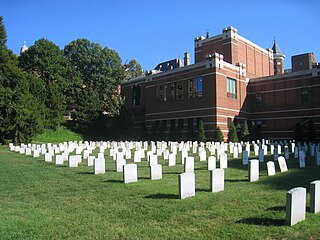
The Jesuit Community Cemetery on the campus of Georgetown University in Washington, D.C., is the final resting place for Jesuits who were affiliated with the university. It was first established in 1808 and was moved to its present location in 1854.
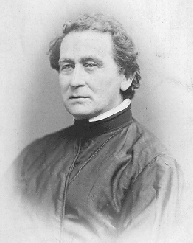
Anthony F. Ciampi was an Italian-American priest of the Catholic Church and member of the Society of Jesus.
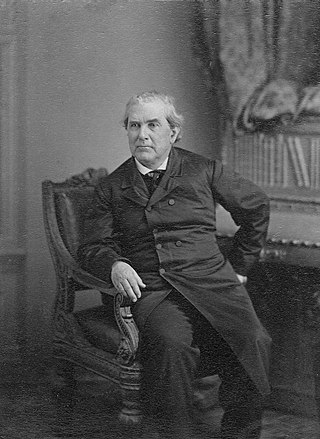
Charles Henry Stonestreet was an American Catholic priest and Jesuit who served in prominent religious and academic positions, including as provincial superior of the Jesuit Maryland Province and president of Georgetown University. He was born in Maryland and attended Georgetown University, where he co-founded the Philodemic Society. After entering the Society of Jesus and becoming a professor at Georgetown, he led St. John's Literary Institution and St. John the Evangelist Church in Frederick, Maryland. He was appointed president of Georgetown University in 1851, holding the office for two years, during which time he oversaw expansion of the university's library. The First Plenary Council of Baltimore was held at Georgetown during his tenure.

Robert Wasson Brady was an American Catholic priest who led several Jesuit institutions in the United States. He served twice as the president of the College of the Holy Cross from 1867 to 1869 and from 1883 to 1887. He was also the second president of Boston College from 1869 to 1870 and the provincial superior of the Jesuits' Maryland Province from 1877 to 1882.




















